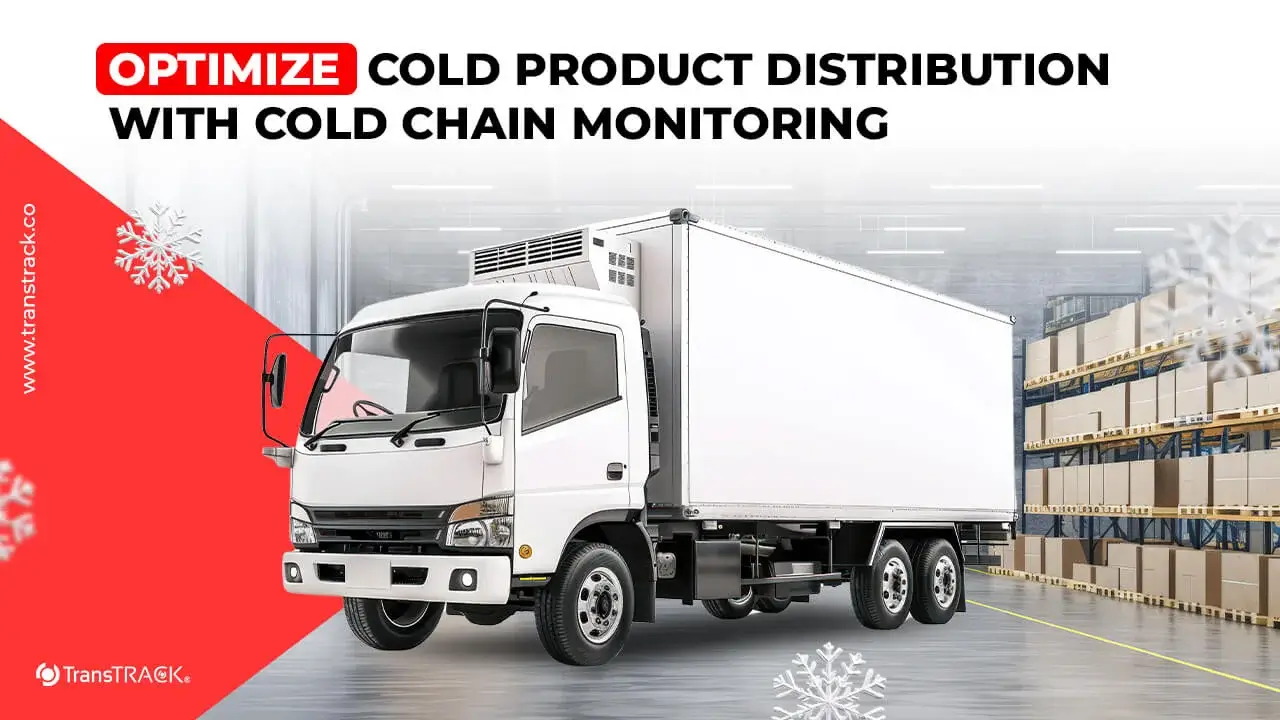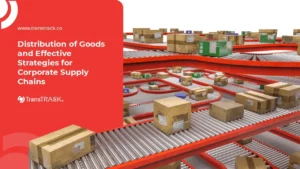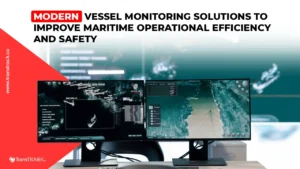Optimize Cold Product Distribution with Cold Chain Monitoring
Posted on September 22, 2025 by Nur Wachda Mihmidati

Temperature-sensitive products-such as vaccines, medicines, fresh meat, and dairy products-require consistent temperature control throughout the distribution process. Without proper monitoring, product quality and safety can suffer before it even reaches the consumer.
This is where cold chain monitoring comes in: a real-time temperature and humidity monitoring system that ensures every stage of the cold chain, from storage to delivery, is always under optimal conditions. With this technology, companies can maintain product quality, meet regulatory standards, and reduce the risk of loss. Check out the full explanation with TransTRACK!
What is Cold Chain Monitoring
Cold Chain Monitoring is the process of continuously monitoring and controlling temperature throughout the distribution chain of products that require cold conditions-from storage, transportation, to the final point of receipt. This system ensures that temperature-sensitive products, such as vaccines, medicines, fresh foodstuffs, meat, dairy products, and certain chemicals, remain within a safe temperature range for quality and safety.
Why Cold Chain Monitoring is Important
Cold Chain Monitoring is crucial because temperature-sensitive products-such as vaccines, medicines, fresh meat, dairy products, or certain chemicals-can quickly spoil or lose effectiveness if not stored and transported at the right temperature. Here are the main reasons why this monitoring system is important:
1. Maintaining Product Quality and Safety
- Consumer Health: Defective vaccines or food can pose serious health risks.
- Product Integrity: Maintaining temperature ensures the potency of drugs remains effective and foodstuffs stay fresh.
2. Meeting Regulatory Standards
- The pharmaceutical, food and chemical industries have strict requirements from regulatory agencies such as BPOM or WHO.
- Documented temperature monitoring helps companies pass audits and avoid sanctions.
3. Reduce Financial Losses
- Product damage due to temperature fluctuations can be costly.
- Monitoring systems provide early warning, enabling corrective action before damage occurs.
4. Improve Operational Efficiency
- Real-time data helps with route planning, refrigeration equipment maintenance and stock management.
- Historical analysis reveals problem patterns to make the distribution process more efficient.
5. Building Market and Consumer Confidence
- Transparency of storage conditions increases the trust of customers, business partners, and health authorities.
- Proof of temperature data can be used for insurance claims in case of problems.
6. Supports Sustainability
- Reduces food or drug wastage due to spoilage.
- Reduced carbon footprint as redistribution of failed products is avoided.
How Cold Chain Monitoring Works
In order to maintain the quality of temperature-sensitive products, cold chain monitoring works through a series of interconnected stages. Here are the main flows that ensure every temperature data is recorded and monitored in real-time:
- Temperature & Humidity Sensors
- Sensors are installed in refrigerated storage rooms or vehicles to measure temperature and humidity continuously.
- Data Logger
- Data from sensors is stored and logged by data logger devices, which have internal memory and connectivity to keep information safe even if the network is disconnected.
- Cloud/IoT Platform
- Data loggers send information to a cloud-based server via an IoT network, enabling real-time temperature processing and analysis.
- Dashboard & Notifications
- The operations team monitors the results through a web or app dashboard, complete with temperature graphs and automatic alerts when deviations occur.
With this flow, every stage from measuring, recording, to monitoring, is integrated to keep products safe throughout the distribution chain.
Benefits of cold chain monitoring for Industry
Cold chain monitoring adds great value to sectors that rely heavily on controlled temperatures. Here are the main benefits in each industry:
1. Food & Beverage
- Keeping Products Fresh: Ensure meat, fish, dairy products and fruit remain at safe temperatures from warehouse to sales shelves.
- Avoid Food Recall: Documented temperature data helps prevent product recalls due to damage or contamination, protecting brand reputation.
2. Pharmaceuticals & Vaccines
- Regulatory Compliance: Meets Good Manufacturing Practice (GMP) and Good Distribution Practice (GDP) standards with evidence of complete temperature monitoring.
- Maintain Drug Potency: Vaccines, insulin, and biological products remain effective until they reach the patient because the cold chain is maintained.
3. Logistics & Distribution
- Route Efficiency: Real-time data allows setting the most optimal delivery path, reducing delays.
- Cost Savings: Reduce product damage and re-shipment costs, and maximize fleet utilization.
Conclusion
Cold chain monitoring is a critical element in maintaining the quality and safety of temperature-sensitive products, from the storage process to final distribution. With integrated temperature monitoring-through sensors, data loggers, cloud/IoT platforms, and dashboards-any irregularities can be detected in real-time.
For the food & beverage industry, this system ensures product freshness and reduces the risk of food recalls. In pharmaceuticals and vaccines, cold chain monitoring supports GMP/GDP standard compliance while maintaining drug effectiveness. Meanwhile, the logistics sector gains route efficiency, cost savings, and distribution transparency.
Overall, the implementation of cold chain monitoring not only meets regulatory standards, but also protects consumers, minimizes losses, and strengthens market confidence.
Cold Chain Monitoring FAQ
1. What is cold chain monitoring?
Cold chain monitoring is the process of continuously monitoring and recording temperatures along the distribution chain of products that require cold conditions-from storage warehouses, transportation, to receiving points. The goal is to maintain the quality and safety of products such as fresh food, medicines, and vaccines.
2. Why is cold chain monitoring important in pharmaceuticals and vaccines?
Pharmaceutical products and vaccines are very sensitive to temperature changes. If they are not stored at the right temperature range, their effectiveness may decrease or be completely lost. Monitoring systems ensure compliance with Good Manufacturing Practice (GMP) and Good Distribution Practice (GDP) standards, while protecting patients from the risk of using products that are no longer suitable.
3. How does the cold chain monitoring system work?
Temperature and humidity sensors are placed in storage rooms or refrigerated vehicles. Temperature data is recorded by data loggers, then sent via IoTnetwork to the cloud platform. The operational team monitors the conditions in real-time through a dashboard that provides automatic alerts when the temperature deviates from safe limits.
4. What technologies are used to monitor cold chain temperatures?
Some common technologies include:
– IoT sensors for temperature and humidity measurements.
– Data logger with cellular, Wi-Fi, or Bluetooth connectivity.
– Cloud platform for data storage and analysis.
– Web-based dashboard or mobile app for visualization and real-time notifications.
5. How to choose the right cold chain monitoring system for your business?
Consider the following factors:
– Accuracy and temperature range of the sensor as per product requirements.
– Connectivity (cellular, Wi-Fi, or hybrid) to suit distribution conditions.
– Scalability to support a growing number of locations and fleets.
– Integration with existing logistics management systems or ERP.
– After-sales services such as technical support and operator training.
Cold chain monitoring is not just about monitoring temperature, but also ensuring every stage of distribution-from the warehouse to the end point-is safe, efficient and compliant. With real-time monitoring, documented data, and early warnings, companies can maintain product quality, reduce loss costs, and meet stringent regulations.

To optimize the entire cold chain process, TransTRACK presents the Logistic Service Integrator that connects the cold chain monitoring system with your logistics management. This solution enables temperature, fleet, and route tracking in one unified platform, so that sensitive product shipments are quality-assured.
Improve your business’ cold chain reliability with TransTRACK Logistic Service Integrator, monitor temperature, fleet, and distribution in real-time to ensure products are always in the best condition.
Recent Post
Topic :
Recommended Articles

 Bahasa Indonesia
Bahasa Indonesia







